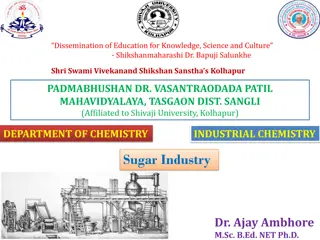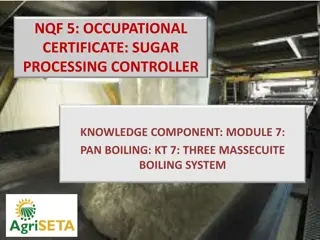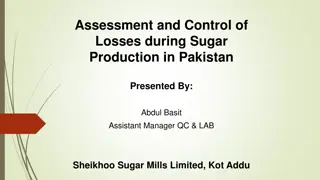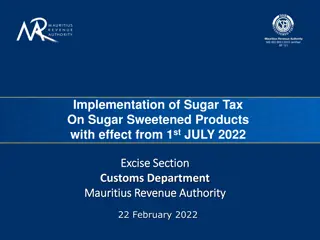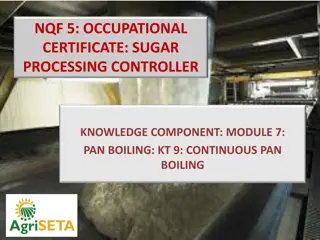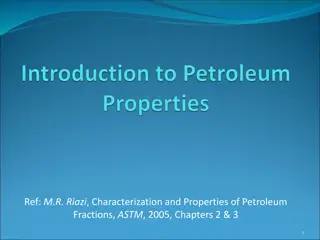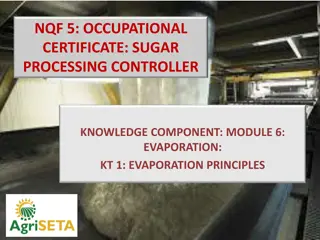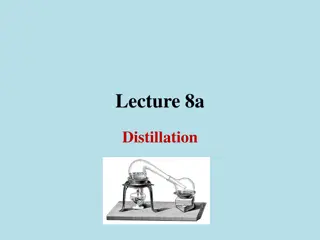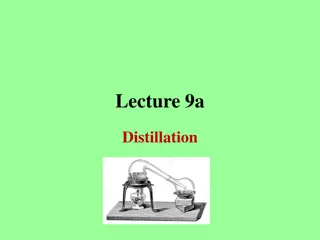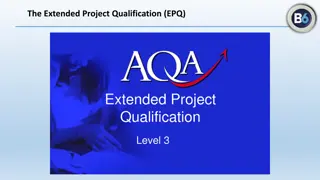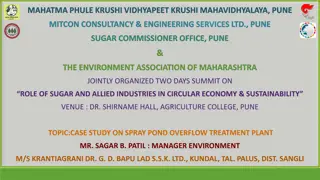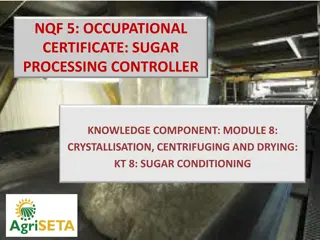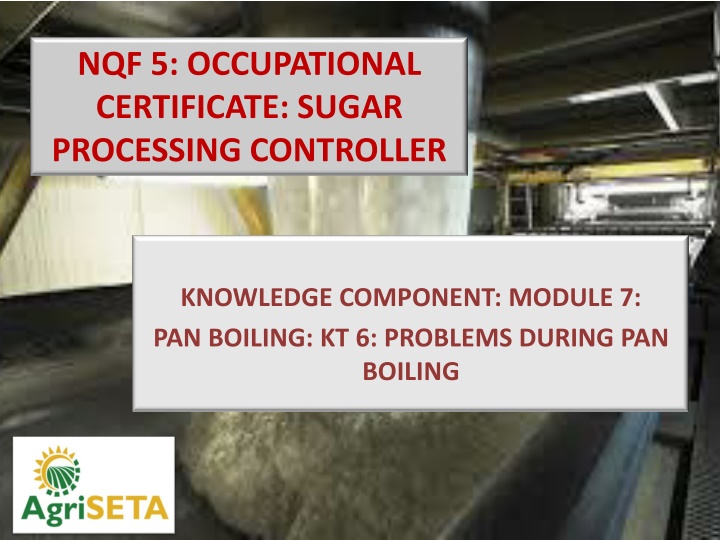
False Grain Formation and Problems During Pan Boiling in Sugar Processing
Learn about false grain formation in sugar processing, the conditions conducive to it, and problems that can occur during pan boiling. Discover causes such as low crystal content, poor circulation, air leaks, and more. Understand what actions should be avoided when false grain forms to prevent issues in the sugar processing industry.
Download Presentation

Please find below an Image/Link to download the presentation.
The content on the website is provided AS IS for your information and personal use only. It may not be sold, licensed, or shared on other websites without obtaining consent from the author. If you encounter any issues during the download, it is possible that the publisher has removed the file from their server.
You are allowed to download the files provided on this website for personal or commercial use, subject to the condition that they are used lawfully. All files are the property of their respective owners.
The content on the website is provided AS IS for your information and personal use only. It may not be sold, licensed, or shared on other websites without obtaining consent from the author.
E N D
Presentation Transcript
NQF 5: OCCUPATIONAL CERTIFICATE: SUGAR PROCESSING CONTROLLER KNOWLEDGE COMPONENT: MODULE 7: PAN BOILING: KT 6: PROBLEMS DURING PAN BOILING
False Grain Conditions Conducive to False Grain: False grain is unwanted grain whose size does not compare with the desired size Is formed during the growing process of existing crystals by secondary nucleation. False grain is thus a new crop of crystal formed during a boiling and is caused when the supersaturation enters the intermediate zone but can also occur in the upper metastable zone. The term false is misleading because the new crystals formed are real sugar crystals which grow in the supersaturated mother liquor.
False Grain (cont.) Conditions Conducive to False Grain: Low crystal content in the boiling massecuite Too few nuclei were introduced during the graining process. This results in a small crystal surface area with the crystals far apart. The sucrose cannot be deposited fast enough so new nuclei come out of solution. Evaporation rate in the pan too fast for the crystallization rate Rapid boiling results in high supersaturations.
False Grain (cont.) Conditions Conducive to False Grain: Poor circulation Poor circulation in the pan results in areas of high supersaturation. A loss of circulation will cause the top of the pan to cool off with an increase in the supersaturation of the mother liquor. Grain in the feed Small crystals in the feed (or in the pan) from a previous boiling. Small crystals move through the centrifugal screen with the molasses and if not removed by molasses conditioning they will serve as nuclei for new crystals. Very large sugar crystals being boiled The relatively large distances between these large crystals results in large diffusion paths for sucrose molecules and hence leads to areas of high supersaturation.
False Grain (cont.) Conditions Conducive to False Grain: Air leaks Cold air leaking into a pan may shock the mother liquor when the supersaturation is near the intermediate zone. This will result in a crop of new crystals. High concentration of certain non-sugars There is a depression in the growth rate in low purity massecuites where the concentration of non-sugars increases during the last part of the boiling. It appears that some of the non-sugars are deposited on the crystal surface preventing growth. As growth slows down the supersaturation increases until secondary nucleation occurs. This can happen in the crystallisers as well, where the cooling increases the supersaturation. Sharp increase in vacuum or a drop in temperature during boiling Turbid feed Small particles introduced with the feed may initiate crystallisation by acting as nuclei.
False Grain (cont.) What should NOT be done in the event of false grain formation is the reduction of steam to the calandria to try and reduce the crystallisation rate. This will certainly reduce the evaporation rate, but in doing so will reduce the amount of vapour to the condenser, resulting in lower condenser water temperatures and increasing vacuum levels. This increases the supersaturation level, makes the mother liquor more viscous, and favours the development and growth of false grain.
False Grain (cont.) The problems caused by false grain are experienced in the centrifugals. Inhibiting curing (centrifuging). The most dramatic effect is when the false grain has grown to a size such that it blocks the passages between the larger crystals and prevents drainage of molasses. Poor quality sugar results and under extreme conditions it is impossible to make an acceptable sugar. Increased sugar losses. If the false grain has had limited growth it does not block the drainage passages in the sugar layer but is carried away with the molasses. This leads to reduced exhaustion and, in the case of C- boiling, to reduced BHR.
False Grain (cont.) False grain must be removed quickly because the longer it is there the harder it is to remove. To re-dissolve false grain the supersaturation coefficient must be reduced to just below the saturation line either by: Diluting the pan contents with water or Heating up the pan by reducing the vacuum (i.e. increasing the absolute pressure) When this is done the massecuite will be slackened off and it will have to be tightened up again later. This must be done gradually or the false grain will come back. If the false grain has grown too much it is impractical to try and re- dissolve it. When removing false grain at the beginning of the boiling, care must be taken not to dissolve the small massecuite crystals.
False Grain (cont.) Towards the end of the strike false grain is difficult to remove as the massecuite is tight and circulation not as good as at the beginning of the strike. Raising the temperature might dissolve the grain but the massecuite will now be too hot to strike and cooling might induce further false grain formation. Water cannot be used at this stage of the boiling as the volume of water required would be too great and sugar and water would be carried over into the saveall.
Aconitic Acid The concentration of aconitic acid in cane sometimes reaches levels such that it crystallises out, usually in the C-boilings. It looks like false grain under the microscope but differs in that it is not re-dissolved readily. To confirm whether the false grain is aconitic acid or not, a sample of massecuite is heated in a saturoscope and observed through the microscope. If solution of the false grain is not affected when the temperature reaches about 80 C, the presence of aconitic acid is confirmed. Alternatively smear a sample of massecuite thinly across a microscope slide and observe under a microscope. To check whether the milkiness is false grain or aconitic acid, simply add a drop of water. If the milkiness disappears, the presence of false grain is confirmed.
Water Dilution of Massecuite in a Pan Sometimes during boiling the massecuite may become more dilute unexpectedly. Causes of this may be: A leaking calandria. When a tube is broken the steam and condensate in the calandria may enter the massecuite in large amounts causing dilution. A badly leaking internal condenser. Water entering the pan because it does not escape fast enough down the condenser tail pipe. This occurs sometimes when the tail pipes discharge into a ring pipe returning injection water to the cooling towers. Such ring pipes must be adequately vented because air is often entrained with the water in the tail pipe when a pan is started up. A badly leaking water or feed valve. A faulty controller In extreme cases the crystals in the pan may all be dissolved. The pan contents must then be returned to the relevant feed tank or, if not possible, used as feed through the cut over-line to another pan.
Loss of Vacuum Causes of loss of vacuum may be: Interruption of the injection water supply. Hot injection water being fed to the pan condenser when the cooling tower fans trip Small losses of vacuum indicate a problem with the vacuum pump or possibly a collapsed tray in the condenser.
Loss of Vacuum (cont.) In such cases the pan must be shut down immediately. As this is an emergency shut down, the steam to the calandria is shut off as is also the pan feed. In contrast to this, a controlled shut down of a pan involves: Partial dilution of the massecuite during boiling (grain must not be dissolved) Shut the feed and steam supplies Shut the condenser water and break vacuum
Pan not Boiling Fast Enough A slowing down of the boiling rate may indicate scaling of the tubes or fouling on the steam side. Cleaning of scale from pan tubes is necessary on A-pans on a monthly or bi-monthly basis. B-and C-pans require less cleaning than A s. A fouling of the massecuite side of tubes in sometimes experienced often late in the season. It may be necessary to boil the pan out with water after every strike. The basic cause of this problem is not known. Incondensible gasses build up in the calandria and can easily be cured by increased venting. Some steam is always lost with the incondensible gasses. Inadequate condensate removal is often detected by banging in the condensate piping or calandria.
Purity of Pan Feed Boiling rates are sensitive to purity and slow boiling may indicate leakage of lower purity materials into the pan feed. Specific impurities (some are oligosaccharides) affect the shape of the crystals growing in the massecuite by inhibiting the deposition of sucrose on some crystal faces. A n extreme case is the formation of needles. In effect, sucrose is deposited on only two faces of the crystals so a marked reduction in crystallisation rate occurs.
Low Brix Feed Low brix feed to a pan markedly increases the evaporation load on a pan. See examples in notes
High Viscosity Massecuites When the massecuites have a high non-pol content the massecuites tend to be very viscous, especially if they contain a relatively large amount of gums. Highly viscous massecuite cannot be boiled at the optimum brix ( tightness ) as they lose their fluidity. Since the brix cannot be increased so as keep the massecuite in the upper part of the metastable zone, the rate of crystal growth and the amount of sucrose recovered from the mother liquor is reduced. Exhaustion is thus reduced. This effect occurs periodically and is unavoidable since it is caused by components in the mother liquor which, in turn, is a function of cane quality.
High Viscosity Massecuites (cont.) Chemicals can be added to reduce the viscosity, but this is expensive and the cost of chemicals must be balanced against the reduced recovery of sucrose that results from boiling at lower brix. The temperature of the pan can also be increased slightly by lowering the vacuum (i.e. increasing the absolute pressure, but this reduces the supersaturation co- efficient).


